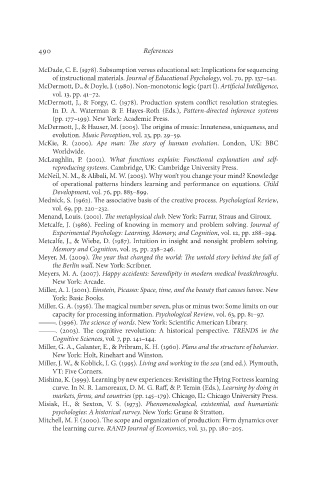Page 507 - Deep Learning
P. 507
490 References
McDade, C. E. (1978). Subsumption versus educational set: Implications for sequencing
of instructional materials. Journal of Educational Psychology, vol. 70, pp. 137–141.
McDermott, D., & Doyle, J. (1980). Non-monotonic logic (part I). Artificial Intelligence,
vol. 13, pp. 41–72.
McDermott, J., & Forgy, C. (1978). Production system conflict resolution strategies.
In D. A. Waterman & F. Hayes-Roth (Eds.), Pattern-directed inference systems
(pp. 177–199). New York: Academic Press.
McDermott, J., & Hauser, M. (2005). The origins of music: Innateness, uniqueness, and
evolution. Music Perception, vol. 23, pp. 29–59.
McKie, R. (2000). Ape man: The story of human evolution. London, UK: BBC
Worldwide.
McLaughlin, P. (2001). What functions explain: Functional explanation and self-
reproducing systems. Cambridge, UK: Cambridge University Press.
McNeil, N. M., & Alibali, M. W. (2005). Why won’t you change your mind? Knowledge
of operational patterns hinders learning and performance on equations. Child
Development, vol. 76, pp. 883–899.
Mednick, S. (1962). The associative basis of the creative process. Psychological Review,
vol. 69, pp. 220–232.
Menand, Louis. (2001). The metaphysical club. New York: Farrar, Straus and Giroux.
Metcalfe, J. (1986). Feeling of knowing in memory and problem solving. Journal of
Experimental Psychology: Learning, Memory, and Cognition, vol. 12, pp. 288–294.
Metcalfe, J., & Wiebe, D. (1987). Intuition in insight and nonsight problem solving.
Memory and Cognition, vol. 15, pp. 238–246.
Meyer, M. (2009). The year that changed the world: The untold story behind the fall of
the Berlin wall. New York: Scribner.
Meyers, M. A. (2007). Happy accidents: Serendipity in modern medical breakthroughs.
New York: Arcade.
Miller, A. I. (2001). Einstein, Picasso: Space, time, and the beauty that causes havoc. New
York: Basic Books.
Miller, G. A. (1956). The magical number seven, plus or minus two: Some limits on our
capacity for processing information. Psychological Review, vol. 63, pp. 81–97.
———. (1996). The science of words. New York: Scientific American Library.
———. (2003). The cognitive revolution: A historical perspective. TRENDS in the
Cognitive Sciences, vol. 7, pp. 141–144.
Miller, G. A., Galanter, E., & Pribram, K. H. (1960). Plans and the structure of behavior.
New York: Holt, Rinehart and Winston.
Miller, J. W., & Koblick, I. G. (1995). Living and working in the sea (2nd ed.). Plymouth,
VT: Five Corners.
Mishina, K. (1999). Learning by new experiences: Revisiting the Flying Fortress learning
curve. In N. R. Lamoreaux, D. M. G. Raff, & P. Temin (Eds.), Learning by doing in
markets, firms, and countries (pp. 145–179). Chicago, IL: Chicago University Press.
Misiak, H., & Sexton, V. S. (1973). Phenomenological, existential, and humanistic
psychologies: A historical survey. New York: Grune & Stratton.
Mitchell, M. F. (2000). The scope and organization of production: Firm dynamics over
the learning curve. RAND Journal of Economics, vol. 31, pp. 180–205.

